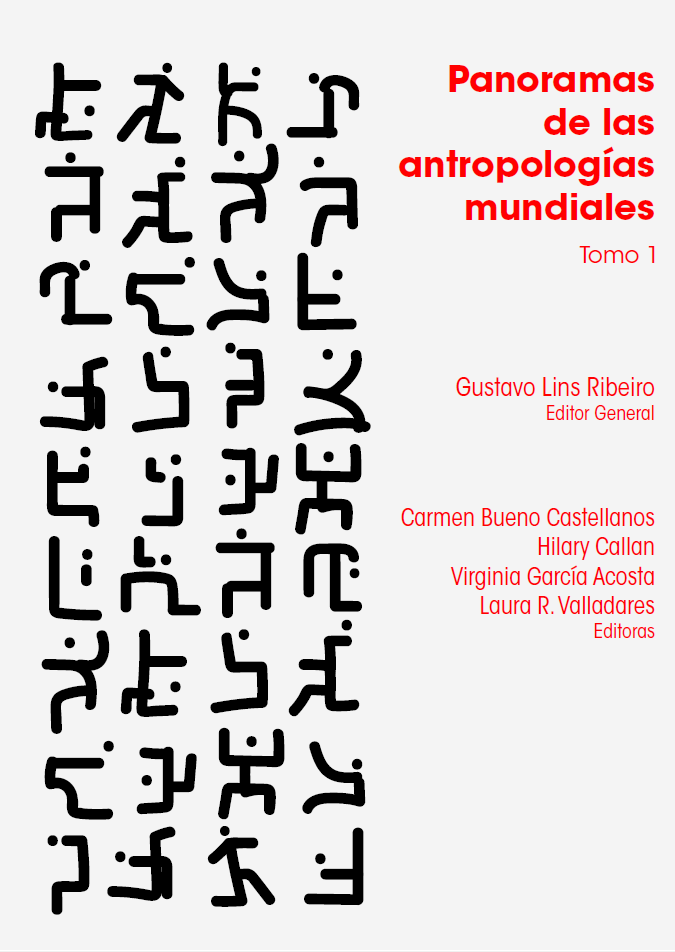From the dark side of the moon to the rising suns. The exercise of comparison in its own right
- Rosana Guber
- ― see biodata
From the dark side of the moon to the rising suns. The exercise of comparison in its own right
Receipt: January 7, 2024
Acceptance: January 9, 2024

Panoramas of world anthropologies
Gustavo Lins Ribeiro (ed. Gral.), Carmen Bueno Castellanos, Hilary Callan, Virginia García Acosta and Laura R. Valladares (eds.), 2023 CIESAS/UAM-I/UAM-L/ Universidad Iberoamericana, Mexico.
The two volumes that make up this book present, in Spanish, the contributions of 35 authors on the anthropologies of their respective countries, plus an introduction by Brazilian editor Gustavo Lins Ribeiro and a chapter on the "Anthropologies of the World" approach by Colombian Eduardo Restrepo. The body of the work consists of 27 chapters on nations, two on politico-continental regions (sub-Saharan Africa and post-socialist Europe) and one on a sub-national region (Siberia), plus an opening chapter on the place of the discipline in Unesco, a global institution in its own terms. These articles were written by several authors called some years ago by Lins Ribeiro himself to compose the line "Anthropologies of the World" of Hilary Callan's great work, the International Encyclopedia of Anthropology, published by Wiley & Sons in 2018. Throughout its twelve volumes, the anthropology of the selected countries is interspersed in strict alphabetical order with thematic "entries" concerning food, economics, politics, arts and religion, conflict, public anthropology, and a careful selection-also by Lins Ribeiro-called "Biographies," featuring notable colleagues from around the world: e.g., Brazilian Roberto Cardoso de Oliveira, Argentine Esther Hermitte, Indian Irawati Karve, South African Archie Mafeje, Mexican Angel Palerm, Japanese Tadao Umesao, along with the renowned heroes of North Atlantic anthropology: Franz Boas, Max Gluckman, Edmund Leach, Claude Lévi-Strauss, Bronisław Malinowski, Marcel Mauss, Alfred R. Radcliffe-Brown, Victor and Edith Turner, as well as of outstanding influencers (today we would call them so) of anthropological thought, such as Karl Marx, Friedrich Engels, Antonio Gramsci and even Immanuel Kant and Adam Smith.
Thanks to the generous decision of Lins Ribeiro, Hilary Callan and the editors Carmen Bueno Castellanos, Virginia García Acosta and Laura R. Valladares, we are faced with a selection that, in Spanish, can become a powerful source of anthropological imagination.1 Those of us who have long been dedicated to unraveling the particularities of our anthropologies have limited ourselves to recognizing regional differences and similarities and, more or less implicitly, to contrasting (and coupling) our work with metropolitan anthropologies: today the North American, French and British; a century ago the German and Italian-speaking ones. And despite the fact that, well into the 20th century xxiWhile we show signs of having begun to understand that the anthropologies we call "classical" are, in turn, local and national responses to historical, political and social processes, those of us who do, think, write and teach anthropology from "the rest of the world" have stubbornly conceived of ourselves as the dark side of the moon.
Now, the passage from the scattered entries in the 12 volumes of the EncyclopediaThe fact that we have a couple of volumes, with their various themes in alphabetical order, in which our real existing anthropologies, one after the other, are discriminated, in their own right, is not trivial. It results in a product that can be approached from different angles and dimensions. I propose, in these few pages, to advance in an entry to this work that is properly anthropological, that is to say, respecting the founding paradox of our discipline: diversity in the unity of the human race... and its anthropologies.
First of all, the editors of Panoramas... grouped the entries by global region (Asia and Oceania), continent (Africa, the Americas) and subcontinent (Western Europe, Eastern Europe, Scandinavia). Inside, they alphabetized each of the national sections (Argentina, Brazil...). They also transformed these entries from English into Spanish.2 This material, divided into chapters that follow one after the other, makes available to those of us who read, speak and think in Spanish, a sort of "everything you always wanted to know about anthropology elsewhere". As if it were a museum, from its colorful showcases where everything seems within reach, even the strangest. A painter's palette. An interesting sample case. A toolbox?
One of the first effects of reading the collection and translation of pieces written in English on anthropologies that are exotic to us is precisely the proximity, the entry of these anthropologies to our daily table or, more concretely, to the menu of the possible: chicken, pasta, but also rice, pork, taro, beans, bread and chocolate. Perhaps a new step that allows us to relativize the idea that Globalization can only be written and understood in English, like Globalization.
In the course of the chapters, readers will notice that anthropology was born, has been, is and, apparently, will continue to be an eminently global discipline. Colonialisms were the cradles of a discipline that was made to think and study humanity through its wild (so untamed, persistent, rebellious, always threatening?) differences. Thus, those of us who have practiced anthropology have generated discourses of what Lins Ribeiro called "cosmopolitics". The "Introduction" and Restrepo's chapter with that of Nuria Sanz on anthropology at Unesco present some reflections in this regard. But, in addition, these cosmopolitics can be traced in each and every one of the chapters, both in the regional and epochal ones, as well as in the subnational one on Siberia and those strictly circumscribed to nation states. "The unity of the anthropological genre" has different ways of expressing itself and different ways of recognizing itself. There are the routes of colonization, both overseas and "ultraterrestrial" (to the Siberian steppes or to the west of the vast North America and the Amazonian South America). There are the problems that these routes make viable and denounce, such as the slave trade, indentured labor (indentured labor) and migrations of peoples across the Mediterranean, Central America and Mexico, refugees from the Near East and missionary migrants to promised lands. There are the nominative traditions that circulate as l'ethnologie, ethnology, the Volkskunde and the Volkerkundefolklore and Cultural Anthropology, among others. There are also the authorial transits of colleagues who migrate permanently or temporarily, such as Boas, Malinowski and Radcliffe-Brown, to the usa uuLévi-Strauss to Brazil or Johannes Fabian to the Congo, and there are those who move through their works.
The world is smaller than the hypnotic effect of its diverse showiness. The multiplicity of "entries" in these 790 pages makes it possible to discover, by their editorial contiguity, how sub-Saharan anthropologies emerge in Latin American anthropologies (and vice versa), Soviet anthropology in Eastern European and Latin American anthropology, Indian anthropology in American anthropology and, above all, Euro-Western anthropologies in those of the "rest of the world". This perspective, relatively scarce in our work, it could have a Panoramas... as its starting point or, at least, its inspiration.
Certainly, we cannot and do not wish to avoid the fatal attraction of diversity. But what exactly do we mean by such a term? More to the point: how do we apply the stock of anthropological knowledge to understand "world anthropologies"? Diversity manifests itself in authors, denominations; also in anthropological problems or objects, concepts, theoretical lines, traditions, institutional dynamics, venues, dissemination and communication systems within those countries. It is everything that contributes to what Roberto Cardoso de Oliveira called "styles" and that does not limit us to be, nor to behave, nor to conceive of ourselves as mere peripheral replicas of the anthropologies of the center (Cardoso de Oliveira and Ruben, 1995).
However, diversity is more than what each national anthropology has and produces (for the world market of anthropological knowledge and its cosmopolitics). It is also its "open veins", as Eduardo Galeano said, with all its wounds. Wars, persecutions, "natural" catastrophes, environmental destruction, revolutions and dictatorships shape peoples and are shaped by them. Then, they also shape their anthropologies, such as the Mexican Revolution, Stalinism, the Pacific War, the apartheid. Historical wounds are true midwives of anthropological traditions, academic alignments and institutional struggles... through the written word, the diatribe and the coup de salon, the purge and the exile. And because they are so endured and confronted, that is to say, so endearing, they also generate interesting and heartfelt problems of knowledge.
In this perspective of Panoramas there is room for other diversities. One is what we could call the "Jewels of the national anthropologies", which are their revered personalities, some fallen in disgrace, others cursed and vindicated, some flagship, others apocryphal, those overcome and those still in force. How and why did they rise and fall? What were their networks, their launching platforms, their national and international alliances, their academic and political relations? What were their ethnographic fields, their preferred notions, their main works and their frames in the different anthropological branches? By virtue of which internal or external approaches were they debated? How did institutional constructions and state factions intervene in their well- or ill-gotten trajectories?
Another diversity is the thematic, inscribed in national, regional and international anthropological agendas. There are issues that come packaged from North Atlantic anthropologies, but there are others that result from more limited cultural, political and humanitarian concerns or that result from the appropriation and nativization of metropolitan, epochal and conjunctural agendas. Feminism, human rights, desertification, racism, ethnosIndigenous rights do not mean the same thing, nor are they practiced in the same way in different countries and throughout the ages.
Another interesting diversity shown in these chapters is so obvious that it is often invisible to us: the relationship between our anthropologies and our States (national, departmental, provincial and local). We could include here how anthropologies are affected by changes in party orientation - as in socialist Eastern Europe -, by regime change - democratic, authoritarian - and by change of government. We could also consider which anthropological agendas correspond, develop or are aborted due to the agendas of our states, and how our anthropological fields, theories, practices and problems relate to them.
Another diversity is exhibited by the authors of each chapter themselves, colleagues who have generally become anthropologists in the countries they write about. Each has different patterns of historicization (time, causality, meaning), different criteria to justify the selection of their most relevant personalities and to characterize the particularities of their national and subnational anthropology(s). In relation to this, it is significant to compare the ways in which the authors describe and, consequently, explain their own disciplinary histories, which are the political and academic alignments and who are the most stubborn contenders.
Panoramas of world anthropologies allows us to leave the noratlantic-centrism and inscribes us in the more general processes of our socio-cultural and political-economic realities, as well as in the biographical and authorial cycles of our colleagues; it helps us to learn how, in other contexts, different problems of knowledge and survival that now affect us have been solved or, at least, faced (the toolbox!); it allows us to analyze the relationship between our anthropologies and historical vicissitudes, but not as determinations, but as possibilities in the dialogues of multiple effects in the thematic selections, in the professional profiles, in the theoretical elaborations, in the field practices, in the formulations of each finding and, surely, in the paths that our productions follow. It also leads us to visualize how our anthropologies are organized and how they are classified internally and in relation to other anthropologies and other disciplines. But, above all, it pushes us towards an understanding of how we think and do "flesh and blood anthropologies" in our countries, with our political issues, with our material and immaterial resources.
In sum, Panoramas of world anthropologies is offered to us as a quarry ready to be explored following the unavoidable practice of our discipline: comparison. And this not only with immediately neighboring countries, nor with countries of global anthropological influence, but also with the anthropologies of the other sections of this book. Thus, in the passage from what anthropologies have in common to what distinguishes them, we could reintegrate into our globalization with a more genuinely universal (Peirano, 1995) and less North Atlantic-centric knowledge.
More than stories, raccontos, accounts, compendiums, chronologies, enumerations, national, regional and subnational entries of Panoramas are an invitation to an anthropological exercise on anthropologies, a mirror that reflects a unique and multiple image at the same time, populated by different accents, colorations and environments, some ignored, most unexpected, all beautifully welcome.
Bibliography
Amid Talai, Vered (ed.) (2004). Biographical Dictionary of Social and Cultural Anthropology. Londres/Nueva York: Routledge.
Bonte, Pierre y Michel Izard (dirs.) [1991] (2013). Dictionnaire d’ethnologie et anthropologie. París: puf.
Boscovich, Aleksandar (ed.) (2008). Other People’s Anthropologies. Ethnographic Practice on the Margins. Nueva York: Berghahn Books.
Callan, Hilary (ed.) (2018). International Encyclopaedia of Anthropology. Nueva York: Wiley & Sons. 12 vols.
Cardoso de Oliveira y Guilhermo Ruben (orgs.) (1995). Estilos da antropología. Campinas: Unicamp.
Didier, Béatrice; Antoinette Fouque y Mireille Calle-Gruber (dirs.) (2013). Le Dictionnaire Universel des Créatrices. París: Édition des Femmes. 3 vols.
Lins Ribeiro, Gustavo y Arturo Escobar (eds.) (2006). World Anthropologies. Disciplinary Transformations within Systems of Power. Londres/Nueva York: Berg Publishers.
Peirano, Mariza (1995). A favor da etnografía. Río de Janeiro: Relumé Dumara.
Poole, Deborah (ed.) (2008). A Companion to Latin American Anthropology. Oxford: Blackwell.
Rosana Guber holds a PhD in Social Anthropology and is a senior researcher. conicetArgentina. She does anthropological research on Argentine anthropologies, the Malvinas/Falklands War (1982) and the ethnographic method. She is the author of The metropolitan savage (1991), Ethnography: method, field, and reflexivity. (2001), From kids to veterans (2004), Ethnographic articulation (2013), Falcon experience (2016), as well as organizer and author of the volumes Field work in Latin America (2018), Sea of war (2022) and, with Lía Ferrero, of Anthropologies made in Argentina (2021-2022). He directs the Master's program in Social Anthropology. ides-eidaes/unsamand co-directs the International Diploma in Anthropological Theories of Latin America and the Caribbean (ditalc) of the Alberto Hurtado University in Chile and the eidaes/unsamArgentina.




